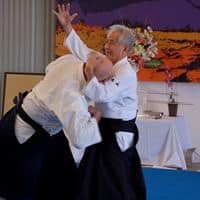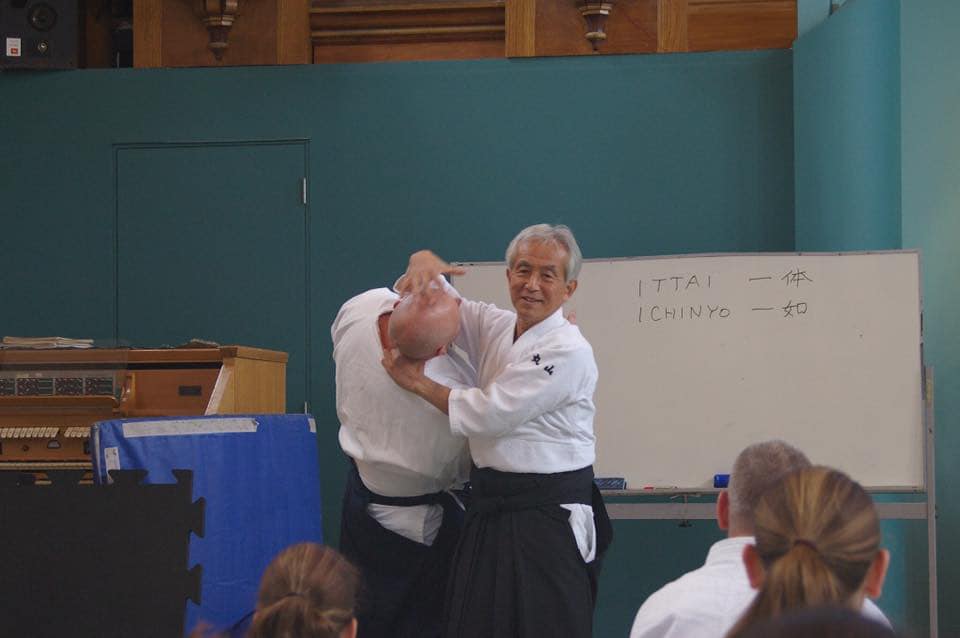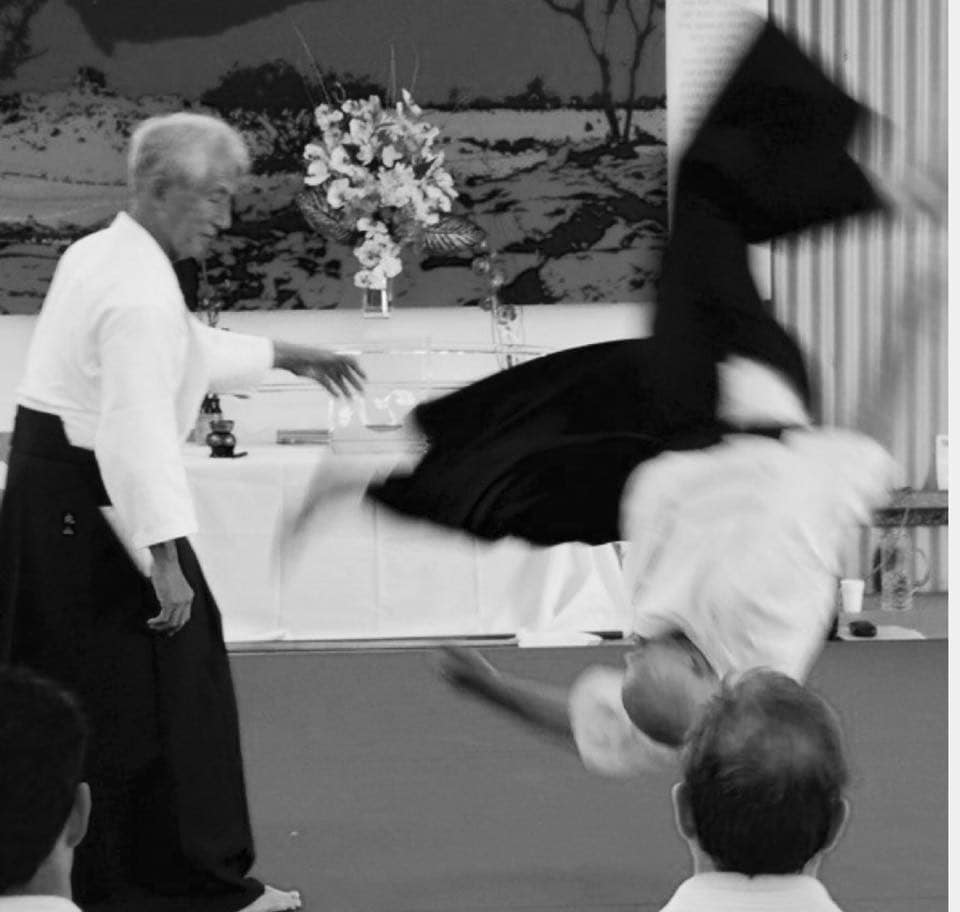


The person that creates the conflict is responsible for resolving the conflict. This is ukemi, this is the ultimate lesson in Aikido.
Yoshio Kuroiwa Shihan
Uke Central To Practice
Yin practice is the expression of “shackled” form. Thus, it is first necessary to be shackled. It is important in training to correctly understand the roles of “uke” and “tori”. Uke’s role is to adjust himself/herself to the movement of tori and tori learns his/her movement with the cooperation of uke. Failure to understand this will lead to the misunderstanding that uke was thrown or pinned because tori’s technique was excellent. Uke absorbs the movement of tori with his body by taking a pure fall. In other words, uke is not thrown but rather is practicing a form in which his role is to be thrown. Thus, the central character in practice is uke.
Usually, in the case of a fighting match, the first requirement is not to succumb to your opponent’s attempt to break your balance. To have lost one’s balance means to have been defeated. In the practice of Aiki, as uke we unconsciously assume that having our balance taken is a good thing. Here exists an important principle and a danger of yin practice. Unless one understands this (i.e. uke and tori are aware of this), practice is meaningless. Practice is possible only due to the existence of a tacit agreement and failure to understand this is a tragic mistake. A certain degree of Intellectualization is possible after recognition of this agreement. Otherwise, this merely leads to conceptual games and self-satisfaction.
NOBUYUKI WATANABE Shihan
Q: Is it different nowadays?
A: It’s different. When I was there it was just at the time when the number of students from the general public were beginning to increase, and the atmosphere gradually changed. Originally Aikido was something practiced by people who had already trained in another Budo and were seeking to improve their skills. When the focus became people without any athletic experience things changed. So now when you say “grab my wrist” there are people who ask “Why should I grab it?”. (laughing) For that reason, in times past ukemi was not taught, everybody just took it naturally.
Q: Who among your Sempai influenced you the most?
A: Of course, Osawa sensei.
Q: Osawa sensei’s name has come up quite a few times in this series of articles, what kind of a teacher was he?
A: He was like a Zen Buddhist monk. (laughing) Maybe you could call him the head clerk – at the time he was the Dojo organizer. His Aikido was soft, but severe. He taught the Kenpei Tai (“Military Police Corps”) during the war, so there was severity in the midst of his kindness. I took ukemi during a demonstration at the Hibiya Kokkaido, but after the demonstration was over he took me to Hombu Dojo and made me take ukemi for one straight hour. “What you’re doing isn’t ukemi. Ukemi isn’t being thrown.” he said.
Q: What did he mean?
A: He meant that just because one is thrown doesn’t mean that it is ukemi. Just flying away isn’t ukemi. “Ukemi is to feel the technique of your partner and detect where they are trying to drop you” he said.
Q: Does that mean that ukemi is training in grasping a sense of your partner?
A: If you think about it, that’s it. Being thrown is that kind of training, that’s why Aikido training is made that way. It’s no good if you are just throwing or being thrown like an object, and being proactive and throwing yourself doesn’t work either. It is training in feeling and detecting a sense of your partner at the time. Now we have training in throwing and training in being thrown. Both sides ought to be working on their sensitivity, but they just cut it off and throw. I didn’t understand that at the time. That’s why I got thrown for an hour straight back then while being scolded “No good! No good!” – but at the end I was told “OK!”. I’ve never been scolded for that again since that time. It was a valuable experience.
Henry Kono
What about teachers?
I don’t think they know enough about uke. They don’t know enough to teach it. They don’t teach uke at all. When I was in Japan it was uke, uke, uke!
What was your personal relationship with O-Sensei like?
When he used to say, “I’m not going to tell you what I’m doing!” I used to whisper under my breath, “Before I go home I’m going to pick your brain.” He and I had a game going.
Getting back to uke…
At Hombu dojo, the teacher teaching the class never talked about uke. It was always the person you’re practicing with who taught you. In Japan, it’s not like here where 80 per cent are white belt, there, 90 per cent are black belt. If you’re training with the right person, they’ll tell you. Falls are self preservation, because if you can’t take them you’re going to get injured.
It was important because it was half of any aikido move. Their thinking was if you get the uke half, the other half is easy to comprehend. Now I feel we concentrate on the throws and the ignore the uke aspect totally.
How do you teach good uke?
You have to do it easily. Students have to accept that they have to learn uke. If they have their mind made up that they are there to throw, they all turn a deaf ear when talk of uke comes up. It’s one half of the whole. Throwing is the easy part. It’s uke that’s hard. You need lots of conversation to get the understanding from someone who knows about it.
How does this change our understanding of aikido?
Because you can feel the move. You’re receptive. When you try to do the move, you can’t see it. When you’re just taking uke, you can see the flow. This is the way you learn. Everybody has the idea that you don’t learn anything from uke. This is why they don’t practice this. We were never taught this way.
So for your first three years in aikido you were only uke?
That was the concept. I used to ask, “I have been doing this for a year and I don’t know what the hell I’m doing.” They said, “Don’t worry Kono-san. Just take uke! It will come clear to you.” It was important to develop this body sensitivity and mobility.
Sensitivity is important…
Because I’m learning exactly what you are doing. You are really becoming yin. You have to be soft. Then the center starts to develop. That’s the only way to develop it.
Kenji Shimizu Shihan
“Judo and Aikido were both originally jujutsu, so they have many points in common. Even when my Judo training could not be useful, it was never wasted. However, in Judo one always pairs with an opponent and then grabs and destabilizes them in order to throw or hold them down. Aikido starts from a greater distance and first separates from the opponent’s attack through tai-sabaki. Even understanding these differences intellectually, at first my body didn’t really follow along. And one more thing. I took a lot of ukemi for O-Sensei, and was made to teach a lot of beginners – I believe that it was because of these two things that I was able to improve. In Judo if one is thrown then they have lost, so there is extremely high resistance to being thrown. In the case of Aikido, if one cannot take ukemi for techniques then they will not improve. That is to say, in Aikido kokyu is important, so learning the kokyu of the uke is also connected to the kokyu of the nage. In ukemi, moving after the technique has become fully effective is too slow. If one practiced Aikido in a competitive format..first you would destroy your body. For that reason, one takes ukemi in order to protect their body in the instant that the technique becomes effective. I had some resistance to that kind of ukemi in the beginning. But as the training continued I think that it gradually sunk in. Ukemi is for protecting oneself, not for just falling on one’s own – if the ukemi does not match the opponent’s kokyu then it has no meaning. For that reason, we are very picky about ukemi in my dojo these days.”
Q: What does it mean to do ukemi that matches the opponent’s kokyu?
A: “For example, if the wind blows then the branches of a tree will bend, right? When the wind passes they return to their former state. But the branches won’t bend on their own if there isn’t any wind. Ukemi in Aikido is the same, it is cooperative, but you can’t just fall down on your own. I came to understand that from teaching large beginners, and from taking a lot of ukemi for O-Sensei, Ni-Dai Doshu and many other instructors in the beginning. No matter how experienced a shihan might be, if they had poor ukemi then O-Sensei was strict with them. After all, he attached great importance to matching kokyu. I was a new participant, so I certainly had some resistance to instigating the falls myself, but I became used to following the movement of the opponent’s throws. For that reason, when O-Sensei applied techniques he must have felt some of that feedback. When I taught O-Sensei almost never gave me direction, and I think that this may have been the reason for that.”
Q: In Judo and Aikido the ukemi is different, did you have to relearn things?
A: It got better naturally. I took a lot of ukemi for O-Sensei, and although he sometimes said “Yes, like that” with regards to my ukemi, he never said “That’s no good.
Master Shinjuro Narita, Soke- Korindo Aikido
No matter how good the sensei is, if the person who is attacking is not honest, it is difficult to handle the situation as freely as he would like.
If you are honest and give your body and soul to the teacher, he will give you everything.
If you resist even only a little bit, it means that you are disobeying the teacher’s will and are not following his ki.
If your body and mind are able to adapt to what the teacher is doing without any resistance, then the essence of the teacher’s both physical and mental teaching has been transmitted to you as it is. There is no other way to learn the essence of the teacher. It is not knowledge, but an unconscious intrinsic ability that is stored in the body itself.
…..
In any case, in order to receive what emanates from the heart of the teacher, you have to empty yourself. If there is any self-consciousness such as doubt, desire, discrimination, judgment, etc. left, it is like putting a stopper at the entrance of the vessel, and you will never be able to receive his will. It’s not that a part of it overflows, but the whole thing refuses to enter, not even a drop.
This is the important part, and we must keep it in mind.
….
One of the last words from my teacher is, “When there is nothing, it is transmitted from the master to the deshi (student).
I believe this means that it is essential for the transmission of the michi (道) that the mind of the master and the mind of the deshi (student) be united in an unobstructed fusion, that they be able to communicate with each other.
Peter Kelly
